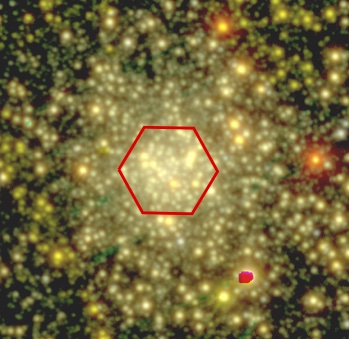Globular Clusters
Contact

| Renbin Yan |
|---|
| The Chinese University of Hong Kong |
Summary
Globular clusters are densely packed, spherical collections of stars. Stars in a globular cluster are born in a very short period of time and are tightly bound together by gravity. Compared to galaxies in which stars are formed over many billions of years with different chemical compositions, stars in a globular cluster can be considered as a population with the same age and nearly identical chemical compositions. Therefore, the integrated spectra of a globular cluster can be an excellent test of stellar population models.
As an ancillary project of the MaNGA Stellar Library (MaStar) project, we observed a small number of globular clusters using MaNGA’s hexagonal fiber bundles. The observations are conducted during bright time, and observed using dithered observations in the same way as MaNGA galaxy survey. The depth of observation varies for different clusters. The clusters are selected to cover a range of metallicities, and are small enough to have its core be covered by MaNGA’s 127-fiber bundles.
Finding Targets
An object whose MANGA_TARGET3 (also known as MNGTARG3) value includes the bitmask in the following table was targeted for spectroscopy as part of this ancillary target program. See SDSS bitmasks to learn how to use these values to identify objects in this ancillary target program.
Note this would select not only the 8 globular clusters but also the surrounding fields around 3 of the bulge clusters (NGC6316, NGC6522, and NGC6528). The surrounding fields can be distinguished from the clusters themselves by their MaNGAIDs. Globular clusters have MaNGAID that start with ’61-‘ while the surrounding fields have MaNGAIDs that start with ‘0-‘.
| Program (bit name) | Bit number | Target Description |
|---|---|---|
| GLOBULAR_CLUSTER | 27 | Globular clusters |
Description
The observations are conducted during bright time, and observed using dithered observations in the same way as the MaNGA galaxy survey. We selected clusters that have a core radius smaller than 15 arcsec, have a V-band central surface brightness greater than 19 mag arcsec-2, and are observable from Apache Point Observatory. The core radius selection is to make sure the largest fiber bundles can completely cover the core regions of the clusters. The clusters selected are grouped into four metallicity bins:
- Rich ([Fe/H] > -0.5): NGC6528, NGC6316
- Intermediate ([Fe/H] ~ -1.4): NGC6229 , NGC6522, NGC6544, NGC 6715 (The latter two were not observed)
- Poor([Fe/H] ~ -1.9): NGC4147, NGC 5634
- Very Poor([Fe/H] ~ -2.3): NGC6341, NGC7078
The depth of observation varies for different clusters due to constraints on observing times. The list of the observed clusters and their plates are listed here:
- Plate 11841: NGC4147
- Plate 11842: NGC5634
- Plate 11843: NGC6229
- Plate 11986: NGC6316
- Plate 11987: NGC6522 and NGC6528
- Plate 12187: NGC7078
- Plate 12767: NGC6341
For three clusters in the bulge region, NGC6316, NGC6522, and NGC6528. We placed several fiber bundles around each of them to get a measurement of the background stellar fields. These could be used to estimate the background bulge population. On the two plates (plate 11986 and 11987) designed for these three clusters, we also placed two fiber bundles on each plate in very dark dusty patches with no stars visible in order to get a measurement of pure sky background. These could be useful for deriving the spectra of these clusters. These can be selected by requiring MNGTARG2==2 AND (PLATE==11986 OR PLATE==11987).


